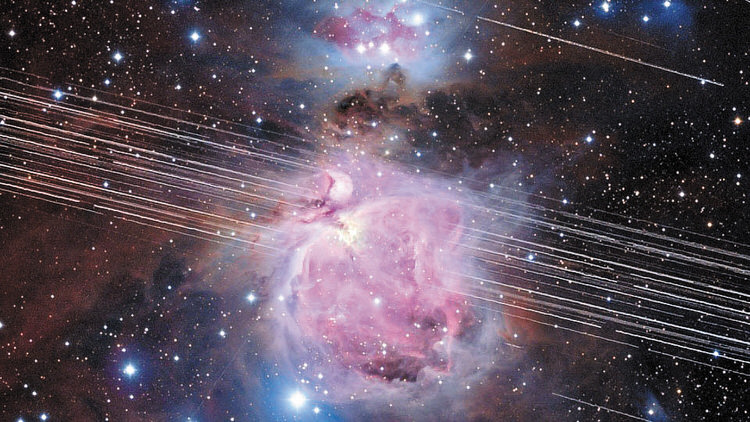
Satellite megaconstellations cause bright streaks across astronomical images. (Photo courtesy of NASA, Amir H. Abolfath)
Sam Miller
The SaddleBrooke Skygazers Astronomy Club is pleased to host Harry Krantz, a Ph.D. student of astronomy at the University of Arizona Steward Observatory, on Sunday, April 23, at the DesertView Theater, 39900 S. Clubhouse Drive, at 7 p.m. Circumstances required cancellation of the scheduled February meeting, but Krantz has graciously agreed to the April program date.
With the creation of new low Earth-orbit satellite constellations, astronomers face a new reality, one with as many as 100,000 bright satellites, which can ruin astrophotographic images, both scientific and aesthetic. While many are concerned with how to avoid these new satellites, Harry is intentionally observing them to measure their brightness and evaluate current and future mitigation goals.
Observing the fast-moving satellites presents a unique set of technical challenges, which are better accomplished with advanced small telescopes than large professional observatories. Through an extensive observational survey now totaling more than 15,000 individual observations, Harry is characterizing the brightness of satellite mega-constellations from an all-sky perspective, which encompasses their dynamic and positionally-dependent brightness. Simple one-time measurements do not fully describe the complex behavior of satellites. The Sun-satellite-observer geometry and reflecting angles determine the apparent brightness, and observing the satellites at positions across the entire sky reveals their reflection pattern, an all-sky photometric signature, which is distinct for each type of satellite. Astronomers can use the all-sky photometric signatures to understand the potential effects to their observations and possibly avoid the brightest satellites and worst impacts.
Krantz’s research focuses on observing and characterizing satellites and debris in Earth’s orbit. With a background in engineering and systems development, Harry creates new instruments, telescope systems, and methodology to overcome the unique challenges in observing satellites. His projects include characterizing rotating bodies with high-speed cameras, rapid object discrimination based on color, detecting far-away objects in non-ideal observing scenarios, and characterizing the brightness of new low Earth-orbit satellite constellations.
The SaddleBrooke Skygazers Astronomy Club meets monthly (and typically) on the second Sunday evening (7 p.m.) at the DesertView Theater. The spring/summer Star Parties are scheduled on Tuesday, May 23, and Thursday, June 8, at the softball field parking lot. The public is welcome to both meetings and Star Parties. Club and Star Party information can be obtained by emailing David Evans at djevans1@me.com.
